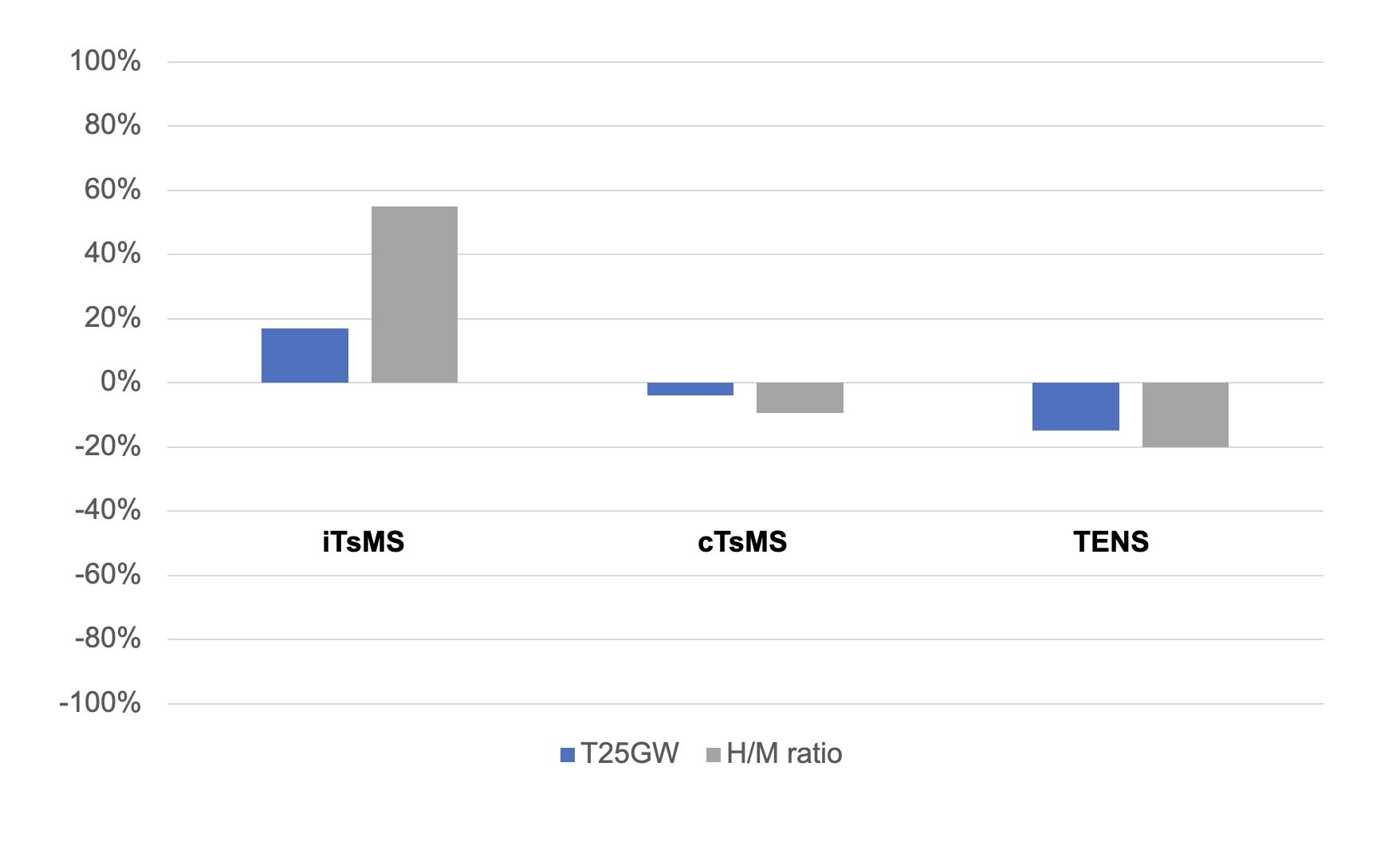Objective: To evaluate the effects of non-invasive neuromodulation techniques transpinal magnetic stimulation (TsMS) and transcutaneous electrical stimulation (TENS) in Stiff person syndrome (SPS).
Background: SPS is a rare autoimmune disorder causing muscle rigidity, spasms and gait impairment. It’s linked to anti-Glutamic Acid Decarboxylase (anti-GAD) antibodies, affecting inhibitory neurotransmission in the spinal cord. Despite treatments like GABAergic drugs or immunotherapy, patients often experience significant gait issues, highlighting the need for better treatments. Non-invasive neuromodulation techniques like TsMS and TENS show promise in reducing muscle tone, but their effects on SPS are not well understood.
Method: In this study, we aimed to evaluate the response of different neuromodulation protocols (intermittent TsMS, continuous TsMS and TENS) in a 51 year-old female with anti-GAD positive SPS. We used the timed 25-foot walk test (T25FW) as the main clinical outcome and the H/M reflex ratio as a neurophysiological marker of spinal cord hyperexcitability.
Our patient was submitted to intermittent TsMS with a circular coil (Magventure Magpro R20), over the T2-T3 level, followed by TENS at the same level for the same duration of TsMS and finally continuous TsMS. There were washout periods between the sessions, varying between 1 and 2 months, and the outcomes were measured immediately after stimulation.
Results: Results showed that continuous TsMS and TENS improved gait speed and reduced neurophysiological evidence of hyperexcitability, while intermittent TsMS worsened both parameters significantly. The results are summarized in Figure 1. These findings suggest that continuous TsMS and TENS exert inhibitory effects, whereas intermittent TsMS has an excitatory impact, potentially exacerbating spinal cord hyperexcitability in SPS.
Conclusion: Although this study has limitations such as its case report design and single-stimuli protocol, the observed effects provide valuable insights. Continuous TsMS and TENS emerge as promising strategies for future neuromodulation studies in SPS, offering potential avenues for improving patient outcomes. Moreover, the contrasting effects of intermittent and continuous TsMS highlight the complex interplay between excitatory and inhibitory mechanisms in SPS pathophysiology.
Variation of T25GW and H/M ratio.
References: M.C. Dalakas, Stiff-person Syndrome and GAD Antibody-spectrum Disorders: GABAergic Neuronal Excitability, Immunopathogenesis and Update on Antibody Therapies, Neurotherapeutics. 19 (2022) 832–847.
[2] R.B. Carra, G.D. Silva, I.B.B. Paraguay, F. Diniz de Lima, J.R. Menezes, A.M. Pineda, G.A. Nunes, J. da S. Simões, M.C. França Jr, R.G. Cury, Controversies and Clinical Applications of Non-Invasive Transspinal Magnetic Stimulation: A Critical Review and Exploratory Trial in Hereditary Spastic Paraplegia, J. Clin. Med. Res. 11 (2022). https://doi.org/10.3390/jcm11164748.
[3] A. Mahmood, S.K. Veluswamy, A. Hombali, A. Mullick, M. N, J.M. Solomon, Effect of Transcutaneous Electrical Nerve Stimulation on Spasticity in Adults With Stroke: A Systematic Review and Meta-analysis, Arch. Phys. Med. Rehabil. 100 (2019) 751–768.
[4] Menezes, Carra, Nunes, Transcutaneous magnetic spinal cord stimulation for freezing of gait in Parkinson’s disease (PD), Mov. Sport Sci. (n.d.). https://observatorio.fm.usp.br/handle/OPI/38852.
[5] Z. Ni, R. Chen, Excitatory and Inhibitory Effects of Transcranial Magnetic Stimulation, Biocybernetics and Biomedical Engineering. 31 (2011) 93–105.
To cite this abstract in AMA style:
V. Maciel, G. Silva, R. Carra, J. Baima, J. Oliveira, M. Silva, P. Lacerda, K. Massruha, C. Heise, C. Tanaka, R. Cury. Clinical and Neurophysiological Response of Different Protocols of Non-Invasive Spinal Neuromodulation in Anti-Gad Positive Stiff Person Syndrome: A Case Report [abstract]. Mov Disord. 2024; 39 (suppl 1). https://www.mdsabstracts.org/abstract/clinical-and-neurophysiological-response-of-different-protocols-of-non-invasive-spinal-neuromodulation-in-anti-gad-positive-stiff-person-syndrome-a-case-report/. Accessed March 6, 2025.« Back to 2024 International Congress
MDS Abstracts - https://www.mdsabstracts.org/abstract/clinical-and-neurophysiological-response-of-different-protocols-of-non-invasive-spinal-neuromodulation-in-anti-gad-positive-stiff-person-syndrome-a-case-report/

